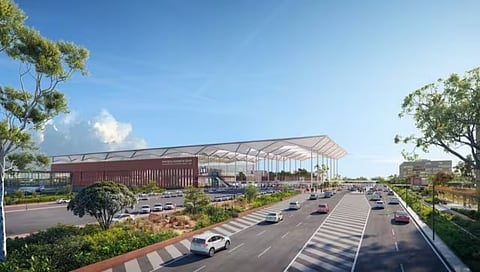

The global aviation body International Air Transport Association (IATA) on Wednesday assigned the code of ‘DXN’ to the greenfield airport which is coming up at Jewar in the Gautam Buddha Nagar district of Uttar Pradesh.
This code is given to every airport as it is used globally for location identification. This is similar to pin code and governed by IATA resolution 763 for location code requirement, officials explained.
For example, the IATA code for Delhi’s IGI airport is DEL, and Mumbai Aiport's code is BOM.
Passengers can find the IATA code for an airport in their flight schedules, tickets and baggage handling communication from one airport to another. These also aid in streamlining and regulating communication, operations, and logistics. In essence, these IATA codes are the basic piece of identification for an airport on every level.
DXN was one among three options shared by Noida International Airport for its IATA code. The global aviation body finally approved DXN as the airport code for the airport which is slated for a launch by the end of 2024.
“This (three letter code) is one of the biggest milestones that the Noida International airport has achieved and the work on the project is going on as per the schedule,” said Schnellmann, CEO of Noida International Airport.
Officials said the unique three letter code serves the important purpose as it helps in standardised communication between aviation stakeholders, enabling smooth operations and reduced errors. It is useful for ticket bookings, boarding passes and bag tag designators, said officials.
According to the IATA Provisions of the Passenger Services Conference Resolution 763, in order to apply for a Location Code, a potential airport candidate must provide an online application form, visual proof of pictures of the structure of the location and signage. In the scenario that the airport is not yet open, it requires a letter from the local civil aviation authority confirming the opening date of the location and it also seeks a confirmation of the commercial scheduled operations that will be performed in the location.
In some cases, the three-letter IATA code may be derived from the city an airport is serving such as DEL for Delhi International Airport, BOM for Mumbai International Airport which serves the city of Mumbai or erstwhile Bombay, while in other cases the three-letter IATA airport code may be totally different from the name of the airport or the city it is serving such as YVZ for Toronto airport.
Sometimes, bus or ferry stations may also be eligible for an IATA three-letter location identifier if these locations are involved in intermodal airline travel.
It is also important to note that an airport is identified not just by an IATA code but also by an ICAO code. The International Civil Aviation Organization (ICAO) is a specialized agency of the United Nations that focuses on the development of international air transport. The ICAO airport codes are four-letter sequences and these are used by pilots and air traffic controllers for communication and on-board systems. For example, the ICAO code for Delhi International Airport is VIDP.
Schnellmann stated that “DXN” stands for the airport’s proximity to Noida, Delhi, and western Uttar Pradesh and that “India’s National Capital Region deserves a second airport” as one of the largest urban agglomerations in the world, according to the report.
